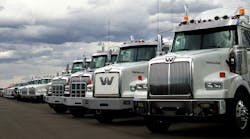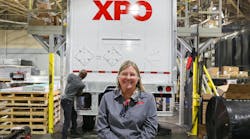LOUISVILLE, KY. Peterbilt Motors Co. announced it is making air disc brakes standard on all its Class 8 truck models. Noting the new federal stopping-distance rules going into effect this summer, Bill Jackson, Paccar vice president and Peterbilt general manager, said air disc brakes offer the shortest stopping distances in the market today and provide a compact design, minimizing weight, reducing maintenance and improving both vehicle and operator efficiency. Peterbilt is the first OEM to make discs standard across its full Class 8 line.
“Air disc brakes are the premium choice for fleets looking to improve driver productivity and minimize downtime,” said Jackson, at a media briefing at the Mid-America Trucking Show here this week. “Standard air disc brakes on all our Peterbilt models ensure we are providing all our customers a solution to comply with the government’s reduced stopping distance regulations going into effect this August, as well as a feature that has a positive effect on their bottom line.”
According to Peterbilt, air discs have a dual, internally adjusted piston design that offers precise automatic brake adjustment and minimal brake force variation for maximum straight line stability. In addition, the OEM stated that optimized friction pairing provides minimal noise and maximum pad and rotor life, which results in extended service intervals, minimal downtime and reduced maintenance costs.
A new across-the-board option for all Class 8 Petes is an extended day cab that expands the length of the Peterbilt day cab by an additional 10 in. and provides nearly 6 in. of added head room.
“Peterbilt’s extended day cab is ideal for customers who require a larger operating environment and increased maneuverability,” said Jackson. “With the large standard rear window, the extended cab also provides superb visibility, making it optimal for vocational, heavy-haul and P&D applications.”
He said the optional cab increases driver’s comfort and productivity as both the driver and passenger seat recline is doubled to 23 deg. and there is 4 in. of added space between the steering wheel and the seat. In addition, 4 cu. ft. of built-in rear wall storage compartments have been added to hold equipment and/or standard hanging files for organizing paperwork.
The extended day cab comes standard with a rear window and is available immediately on Models 389, 388, 386,384, 367 and 365.
Also noted by Jackson was a “short haul” configuration for the Model 382. He said its 110-in. BBC ensures greater maneuverability on city streets and its chassis is designed for urban use. The short-haul 382 also boasts a new interior and a one-piece windshield and is powered by a 9L engine.
Turning to the weighty issue of truck weights, Jackson said that “legislative requirements [including notably engine emissions-reduction systems] have resulted in increased vehicle weight, driving carriers to re-evaluate every component to find a solution that increases operational efficiency.”
To help offset those weight gains, Jackson announced a new lightweight option package that he said will provide customers with the ability to increase efficiency, maximize payload, enhance performance and reduce operational costs.
The package includes a variety of weight-saving components that result in day cabs weighing as little as 14,200 lbs. and sleeper configurations as little as 15,800 lbs.
Jackson said the complete lightweight package includes:
- Paccar MX engine
- Composite springs
- Aluminum components, including cabs
- Batteries and an aluminum space-saver battery box that helps package chassis components to reduce wheelbase requirements. Also, a battery disconnect system preserves the battery power when a truck is idle for an extended period of time, allowing the need for only two batteries instead of four.
- Aluminum 5th wheel and ILS slider
- Rear drivetrain with a proprietary FlexAirsuspension comprised of a lightweight aluminum drive beam providing low weight and ride height. Drivetrain also features the only aluminum rear axle housing unit in the industry, as well as wide-base tires with aluminum wheels for maximum weight savings.
The lightweight package can be spec’d as a complete package or its components individually selected based on customer needs.
Jackson also discussed the greening of Peterbilt’s offerings as the OEM has expanded the expansion of liquefied natural gas (LNG) platforms. He said Pete offers the Models 367 LNG and 386 LNG, which are powered by a Westport engine that provides equal horsepower, torque, and efficiency to a diesel-fueled engine.
“As diesel prices continue to rise, customers are looking for alternative fuel options without impacting performance or service,” Jackson said. “Peterbilt’s Models 367 LNG and 386 LNG with the Westport GX engine provide this alternative, with an added bonus of reduced greenhouse gas emissions.”
The Models 386 LNG and 367 LNG offer up to 475 hp. and 1,750 lbs.-ft. of torque. According to Pete, the 15L Westport GX engine uses high-pressure direct injection, proprietary fuel injectors, (HPDI) fuel system, specialized cryogenic fuel tanks, and associated electronic components to facilitate robust performance and reliable operation.
What’s more, the OEM stated that this technology uses a low-cost, cleaner-burning fuel than diesel with no compromises placed on engine torque, power, fuel economy or driveability, in addition to reducing greenhouse gas emissions by 25%.
“Peterbilt’s design focus is to provide a wide profile of high performing, fuel-efficient products for our customers,” said chief engineer Landon Sproull. “Natural gas power systems complement our other products, such as lightweight aerodynamic conventionals, medium-duty hybrid electrics and idle-reduction systems, all of which exceed customer expectations and requirements.”
He pointed out Pete continues to offer a full range of compressed natural gas (CNG) and liquefied natural gas (LNG) power platforms for its Models 384, 365 and 320, which are equipped with the Cummins Westport ISL-G engine. Efficient and emissions-compliant, according to the OEM, the ISL-G natural gas engine offers a 320 hp. rating and 1,000 lbs.-ft. of torque, “making it an excellent choice for short-haul, regional, refuse and dump trucks with GCW/GVW rated up to 66,000 lbs.”
Peterbilt is now offering speed-control management options on its Paccar MX engine to enable customers to adjust performance parameters to optimize fuel efficiency and performance.
“Weight and fuel economy are key elements businesses are looking to improve,” noted Jackson. “By combining the already fuel-efficient and lightweight MX engine with fuel-efficient speed control management features, Peterbilt provides customers the ideal fuel economy and performance package.”
The two speed-control management options can be specified independently or jointly based on customer needs:
- Progressive shift control encourages drivers to shift at reduced engine speeds (RPMs) while in lower gears
- Gear down protection encourages drivers to shift into higher gears to use the
- engine at a lower engine speed (rpm) when the vehicle is at higher road speeds (mph).
Also new is the line of proprietary Peterbilt premium seats. Jackson said the seats went through extensive design testing to help provide drivers optimal comfort and an enhanced work environment.
Jackson said the seats feature an optional climate control system that provides drivers heating and cooling controls for additional comfort. An automatic height modification feature prevents the seat from changing positions when a driver ascends or descends from the seat. Extra suspension zones within the seat have been positioned to reduce the topping and bottoming of suspensions. In addition, an adjustable shock has been incorporated for drivers to modify damper settings to customize seat positioning to their personal preference.
Other key ergonomic features of the seats include the OEM’s proprietary upper backrest recliner, which pivots at shoulder height to fine-tune the angle of the upper backrest to improve shoulder and neck support, and reduce fatigue over long hauls. Customizable seat positioning features such as the adjustable seat tilt lever and the enhanced fore/aft adjustment range also provide enhanced lumbar support.
Finally, Pete announced it has expanded powertrain options including all wheel drive (AWD) capabilities with the Paccar PX-8 engine. “The PX-8 engine partnered with all wheel drive provides customers maximum power and performance for utility, municipality and vocational applications,” said Jackson. “The combination also provides enhanced fuel economy, durability and overall low cost of operation.”
The PX-8 engine with all wheel drive capabilities is available in Peterbilt Models 337 and 348. The Model 337 is available in both truck and tractor configurations with a GVW of 26,000 – 35,000 lbs. Both the 337 and 348 AWD models are also available with the Paccar PX-6 engine and either Eaton Fuller manual or Allison automatic transmissions.




